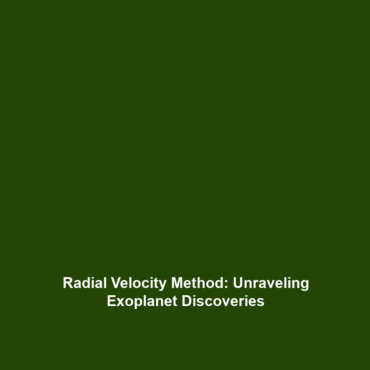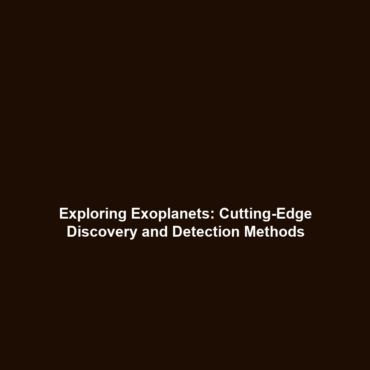Understanding the Radial Velocity Method in Exoplanet Research
The radial velocity method plays a crucial role in the discovery and study of exoplanets, enabling scientists to detect planets outside our solar system by measuring the subtle gravitational influences they exert on their parent stars. By analyzing the wobbles in a star’s movement, researchers gather vital information about potential exoplanets, including their mass and orbital characteristics. This technique not only enhances our understanding of planetary systems but also opens new avenues for exploring potential habitability beyond Earth.
Key Concepts of the Radial Velocity Method
The radial velocity method is based on several key principles that make it an effective tool in the field of exoplanet discovery:
- Gravitational Influence: When a planet orbits a star, its gravitational pull causes the star to move in a slight orbit as well, creating observable shifts in the star’s velocity.
- Doppler Effect: The movement of the star affects the light it emits. When the star moves towards us, its light shifts to the blue end of the spectrum, and when it moves away, the light shifts to the red. This phenomenon is known as the Doppler Effect.
- Spectroscopic Observations: Telescopes equipped with spectrometers measure the spectrum of light from stars, allowing scientists to detect these Doppler shifts and infer the presence of orbiting planets.
Applications and Real-World Uses
The applications of the radial velocity method are diverse, particularly in the context of exoplanets:
- Planet Detection: This method has been instrumental in the discovery of thousands of exoplanets, enhancing our inventory of celestial bodies outside our solar system.
- Orbital Dynamics: Researchers utilize the measured radial velocities to deduce the mass of exoplanets and understand their orbital behaviors.
- Habitability Studies: By identifying exoplanets in the habitable zone of stars, scientists can evaluate potential conditions for life.
Current Challenges
Despite its effectiveness, the radial velocity method faces several challenges:
- Precision Required: Detecting small wobbles in a star’s movement demands highly sensitive instruments and precise measurements.
- Signal Noise: Stellar activity, such as spots on the star’s surface, can obscure the signals caused by orbiting planets, complicating analysis.
- Limited Detection Range: This method is particularly sensitive to larger planets close to their host stars, making it difficult to detect smaller, Earth-like planets in wider orbits.
Future Research and Innovations
The future of the radial velocity method is promising, with several innovations on the horizon:
- Improved Instrumentation: Advances in spectroscopic technology are being developed to enhance detection capabilities and reduce noise.
- Space-Based Observatories: Future missions may employ telescopes in space to avoid the distortion caused by Earth’s atmosphere.
- Machine Learning: The application of machine learning techniques is expected to enhance data analysis, improving the identification of exoplanets amidst stellar noise.
Conclusion
The radial velocity method serves as a cornerstone in the ongoing quest to understand exoplanets, providing critical insights into their existence and characteristics. As advancements in technology continue to evolve, this method will play an even more pivotal role in expanding our knowledge of the universe and the possibilities of life beyond our solar system. For further reading, explore our articles on exoplanet research and radial velocity detection techniques.

